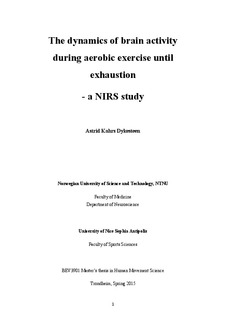| dc.description.abstract | Aim: the main aim of this study was to investigate how the relation between the
cerebral oxygenation (COX) of the prefrontal cortex (PFC) and performance on
prefrontal-dependent cognitive tasks, changes during prolonged, high intensity (HI)
exercise until exhaustion. An additional aim was to see if the changes occuring in the
PFC are exclusive to this region or if they are similar in other regions of the brain.
Method: Three sessions were conducted on an ergometer bicycle with a screen for
cognitive tasks: 1. Learning session for cognitive tasks (Eriksen Flanker (EF) and Nback)
and a VO2max test, determine first ventilatory threshold. 2. One session with
HI exercise and cognitive tasks. 3. One session with low intensity (LI) exercise and
cognitive tasks. The second and third session included measuring the COX during
exercise, as well as recording baseline values before onset of exercise, using a near
infrared spectroscopy (NIRS) system. Regions measured were occipital cortex (OC),
motor cortex (MC), and medial-, dorsolateral (DL)- and right inferior (RI) PFC.
Defined two periods; initial and ending, in order to compare start and end of exercise.
Results: Significant difference between the COX of the MC, and the medial PFC and
DLPFC, and between the MC and the OC, was found, as well as between regions
within the PFC. The O2Hb values of the medial- and DLPFC both increased from
baseline, but were significantly higher in LI than in HI exercise, and in the ending
than in initial period. In HI exercise, the reaction time (RT) on the EF task was
significantly faster in the ending period, without change in accuracy. No significant
changes were found for LI exercise, or for the N-back task.
Conclusion: The findings in this study points to the need of separating between
different regions within the brain, as well as between regions within the PFC, when
talking about the dynamics of the COX during exercise. This study showed that the
dynamical pattern for performance on prefrontal dependent cognitive tasks differed
from the pattern of O2Hb in the regions where these tasks are facilitated, and leaves
the link between the COX and cognition uncertain. Different factors like duration and
intensity of exercise seem to affect both the COX, and more locally in the PFC, in
addition to influencing the complex relation between the COX of the PFC and
performance on cognitive tasks. This points to a need for more extensive recording of
the COX of the MC, the pre-MC and the PFC, in order to have a more informed
image of the complex interaction between the different regions, and between the
implicit and explicit system during exercise. | nb_NO |
